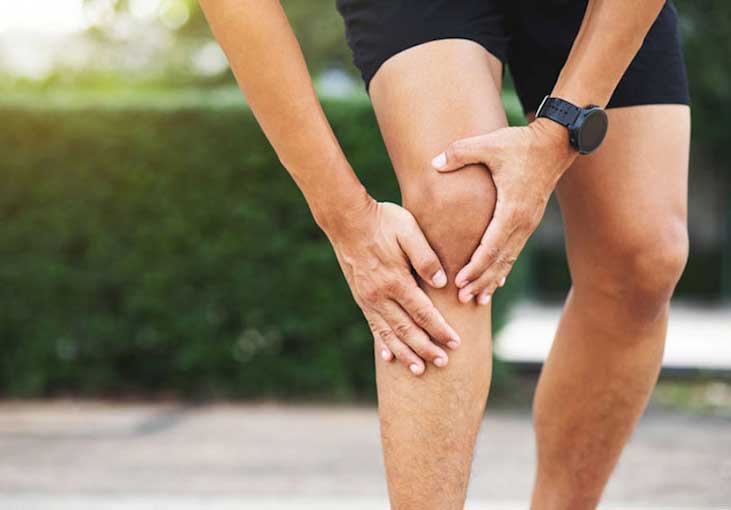Osteoarthritis (OA) is a degenerative condition where the cartilage in your joints wears down, which eventually causes the bones to rub together. OA—particularly in the knees and hips—is more common in Service Members than in civilians. OA in the spine (also called spondylosis) appears to occur at a similar rate in Service Members as it does in civilians, although it’s still a common location for OA diagnosis. In 2018, OA in any joint in the body accounted for nearly 40,000 medical visits. Joint pain is the most frequent medical diagnosis in the military, which makes joint injuries one of the most common reasons for Service Members to seek medical attention. Although joint pain and injuries are some of the most common injuries, OA is one of the most debilitating. It can lead to chronic pain and poor quality of life if it’s not effectively prevented or managed.
Causes of osteoarthritis
Joint pain and injury are among the most common precursors of OA called post-traumatic OA. This means it started to happen after an injury, such as an ACL sprain or meniscus injury in the knee. OA can also be caused by overloading and overuse of joints (without a previous injury). When someone carries heavy loads often or repeatedly kneels, squats, or jumps for months or years, they can also develop OA over time.
On a cellular level, the primary cause of OA is chronic, low-grade inflammation, which can happen after an injury, or it can be caused by other factors such as obesity. Fat cells are important to normal body function, in part because they help regulate hormones. However, too much body fat (as is the case with obesity) can damage these cells, inflame them, and cause them to release pro-inflammation proteins into the body.
Inflammation is a good thing when your body can control it well. It’s a signal that something in your body is damaged, and it’s a way for your body to repair itself by breaking down damaged tissue. However, in the case of obesity, your fat cells are constantly saying, “We’re damaged. Fix us.” This leads to a chronic inflammatory state. When inflammation messengers are released across your entire body—as opposed to staying local to the damaged area—the inflammation can break down otherwise healthy tissue. OA occurs when the targeted tissue is the cartilage in your joints.
Prevent osteoarthritis
You can help prevent OA with at least 150 minutes of physical activity every week and muscle-strengthening activities 2–3 times a week. Some studies have found that physical activity is beneficial, but others found that it was not. However, staying active is a crucial component to maintain other aspects of physical and mental health. In general, the benefits of staying active outweigh the risks.
If you’re obese, weight loss is an effective way to reduce your risk for developing OA. Not only will it decrease the load on your joints, but the optimal eating patterns and increased exercise required for weight loss also reduces inflammation in your body. If you have a muscular build that contributes to BMI classification as obese, you should focus on improving your body composition in order to maintain an optimal level of body fat.
Another way to prevent OA is to reduce your injury risk. Training to improve neuromuscular control (how well you coordinate your movements) can prevent injuries in athletic and military populations. Ideally, if you prevent an initial injury from occurring, it can help reduce your risk of developing post-traumatic OA. However, injuries are very common in the military. But just because you have been injured in the past, it doesn’t mean you should give up on any injury-prevention strategies. You can still reduce your risk of reinjuring the same body part or sustaining another injury.
Manage arthritis pain
No “cure” for osteoarthritis has been found, so the best course of action is to reduce your pain and prevent it from getting worse. If the pain gets bad enough, your physician will discuss joint-replacement surgery, where the arthritic bone is cut out and replaced with an implant. Joint-replacement surgery outcomes are getting better as medical research and technology advance, but non-surgical management is often the preferred route until pain or dysfunction is too great.
Low-impact exercise—such as walking, cycling (stationary or on a bicycle), and water-borne aerobic exercise—is effective for managing OA pain and dysfunction. As long as it doesn’t make your pain worse, the key is to find an activity you enjoy and can do regularly. Similar to OA prevention, if you meet the physical activity guidelines of 150 minutes of weekly activity, it can help manage your OA pain.
Neuromuscular control and muscle-strengthening exercises can effectively manage OA pain and dysfunction. As the cartilage in your joint breaks down, it will change how the bones move over each other. Each joint is “designed” to have a fairly narrow tolerance for how much it can deviate from the optimal movement path. A slight change in that path by a millimeter or two is a large change in joint mechanics. When your bones move outside the optimal path, it can contribute to worsening OA. The goal of neuromuscular-control exercises is to help keep the movement of your bones as close as possible to their optimum range.
Muscle-strengthening exercises—such as body squats and lunges—can build hip and knee strength. When you do these exercises, it’s important to let pain be your guide, and avoid deep knee bends if they hurt. You can also do non-weight-bearing exercises (leg extensions and 3-way hip exercises) to strengthen your hips and knees. These exercises won’t be as effective for neuromuscular control because they’re not training a fully-functional movement such as a squat, but they’re good for building strength, especially if your pain levels are relatively high. Then, as you get stronger, you can transition to weight-bearing exercises to work on your control. If you have hip or knee OA, HPRC’s Rx3 program can help you manage your pain. However, you should be examined by your medical provider first to ensure that the program is right for you.
Eat healthy to manage OA
Weight management is an integral part of improving pain and function for obese people with OA. If you’re obese, losing about 5–10% of your weight has been shown to reduce OA symptoms and improve quality of life. It removes the excess load carried by your joints and reduces inflammation in your body.
Plant-forward eating patterns—such as the Mediterranean diet—have positive effects on OA pain, function, and inflammation markers. Foods typically included in these eating patterns (such as whole grains, olive oil, fish, and vegetables) have anti-inflammatory properties that help mediate chronic inflammation. As with any eating pattern, taking in excessive amounts of these foods can still contribute to excess body fat since you aren’t able to use all of the energy it provides.
Scientific evidence is generally mixed when it comes to using dietary supplements marketed for joint health to help manage arthritis pain. You should use caution when you take any dietary supplements, especially for Service Members. You can visit Operation Supplement Safety (OPSS) for more information.
Summary
To help prevent and manage OA, you can:
- Avoid getting injured. Stay fit and use a neuromuscular training program to reduce your injury risk and prevent post-traumatic OA.
- Maintain a healthy body composition through appropriate eating and exercise. The optimal eating patterns and exercise required to keep a healthy body composition will minimize chronic inflammation that can arise in obesity.
- Stay fit and stay strong. Exercise is one of the best OA management tools, regardless of your body composition.





